airbag VOLKSWAGEN GOLF 2007 User Guide
[x] Cancel search | Manufacturer: VOLKSWAGEN, Model Year: 2007, Model line: GOLF, Model: VOLKSWAGEN GOLF 2007Pages: 444, PDF Size: 92.7 MB
Page 90 of 444
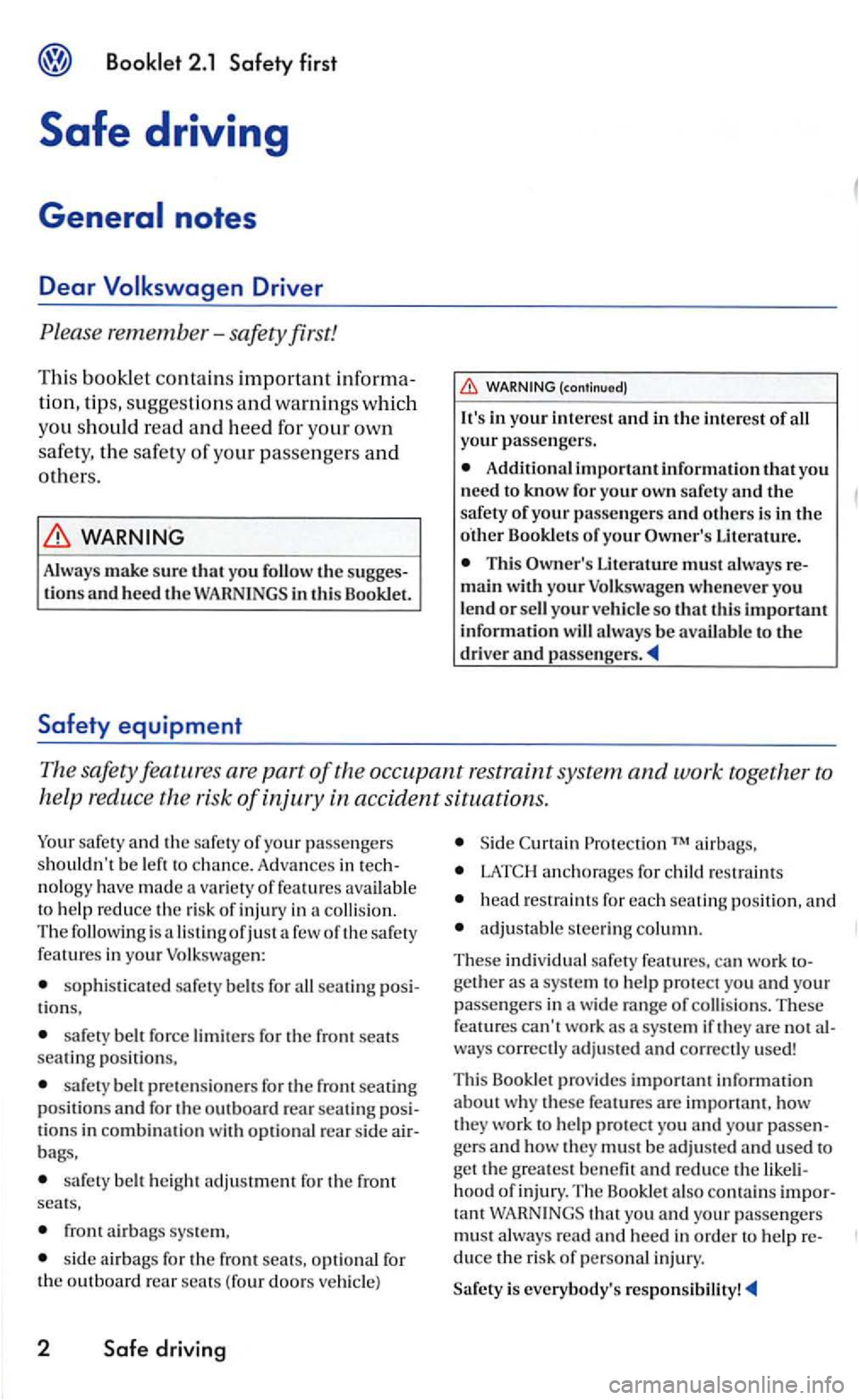
WARNING
Always make sure that you the suggestions and heed th e WARN INGS in this Booklet.
Safety equipment
Additional important information that yo u
need to know fo r you r own safety and the safety of your passengers and others is in the Bookl ets of your Literature.
T his
The safety are part of the occupan t rest rain t system and work together to
help reduce the risk
of injury in accident situation s.
Your safe ty and the safety of your pass enge rs
s houldn 't be left t o chance. Adva n ces in te ch
n ology have mad e variety of feature s available to help red uce the risk of injury in a collisio n.
T he followin g is lis tingofjust a few of th e s afe ty
f e at ures in your Vo lk sw age n:
sophisticate d safe ty belt s for all seating positio n s.
sa fe ty belt force for the front seats
s eati ng po sition s,
safety be lt pre te nsioners for the front seatin g
p ositions and for the outboard rear seating pos i
t io ns in combin ati o n w it h optional re a r s id e air
b ags,
sa fety b elt he ight adjustment for the front s eat s,
fr ont airbags sys te m ,
sid e airb ags for the front seats, optiona l for the outboard re a r seats ( fo u r doors ve hicl e)
2 Safe driving
S id e Protection ai rbags,
h ead res tra in ts fo r ea ch seat in g positi on , and
adjustable s teerin g column.
T he se
individua l sa fety features, wo rk t ogeth er as a syste m to help protect yo u and your passeng ers in a wid e range of collis io ns. T hese features can't work as a sys te m if they are notal
w ays correctJy a dju ste d and correc tl y used!
T
his Bookle t p rov ides important in for matio n
a b out why these features are important, how they w ork to help protect yo u and your passengers and the y m ust be adju ste d and used to get the g re atest ben efit an d reduce the lik eli
h oo d of injury. T he Booklet a ls o conta in s i mpo r
t a nt WARNINGS th a t yo u a nd you r passenge rs mus t alw ays rea d and hee d in order to he lp r e
d uce th e risk o f perso nal inju ry.
Safety is
everybody' s responsibility!
Page 92 of 444
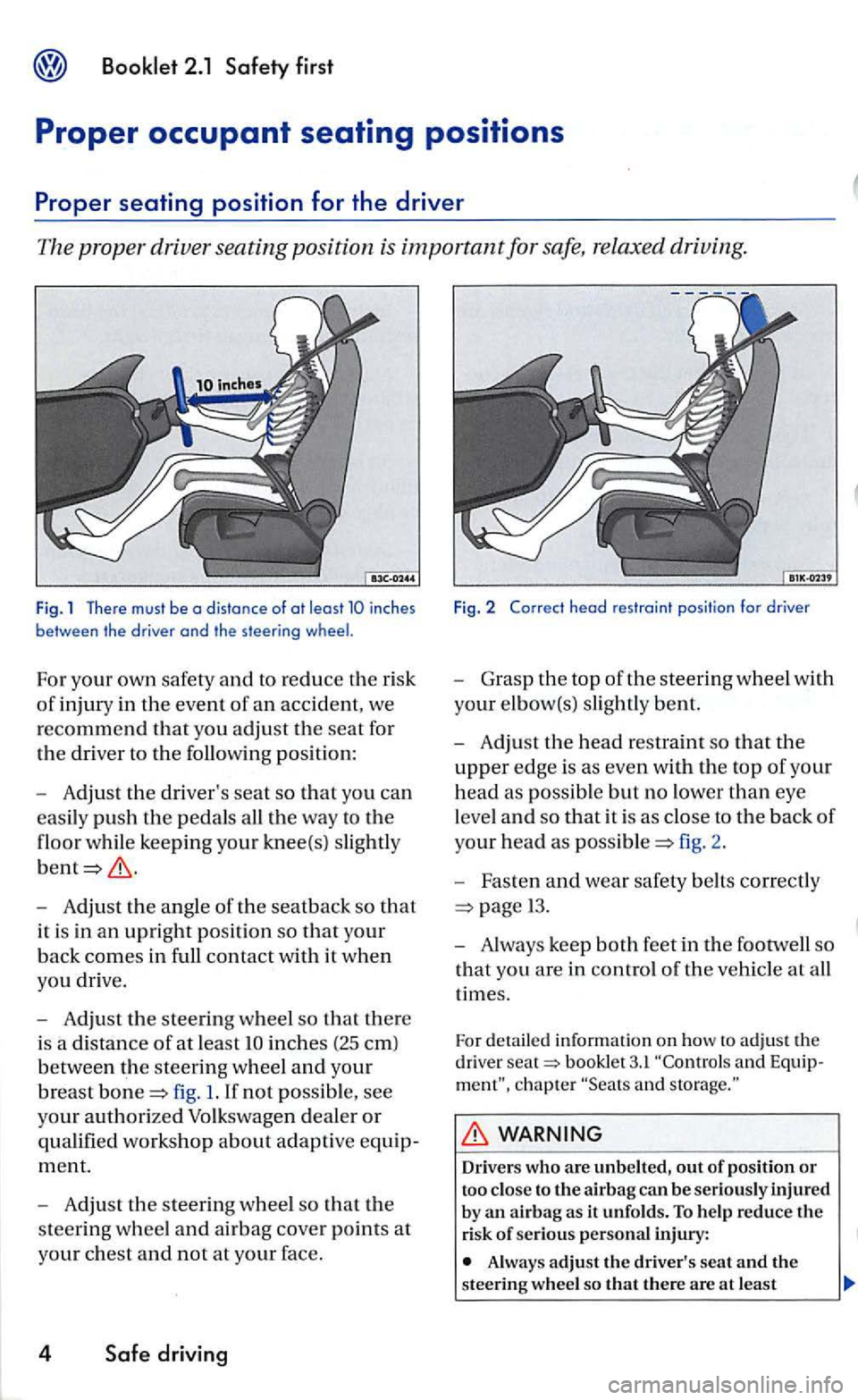
- Adjust the angle of th e seatback so that
it is in an upri ght position so that your
back comes in full contact with it whe n
yo u dri ve.
-
Adju st the s teerin g w heel so that there
i s a dis
tance of at least
fig. 1. If not poss ibl e, see
yo
ur authorized Volksw agen dealer or
qualified workshop about adaptive
fig. 2 .
- Fasten
and wea r safety belts correctly
13.
-Always keep both feet in the footwell so
that yo u are in con trol of the vehicle at all
tim es.
For detailed information on how to adjust th e
d rive r bookle t 3.1 chapter
WARNING
Dr ivers who are unbelted, out of pos itio n or too close to tl1e airbag can be serio usly injured by an airbag as it unfold s. To help reduce the risk of seriou s personal injury:
Page 93 of 444
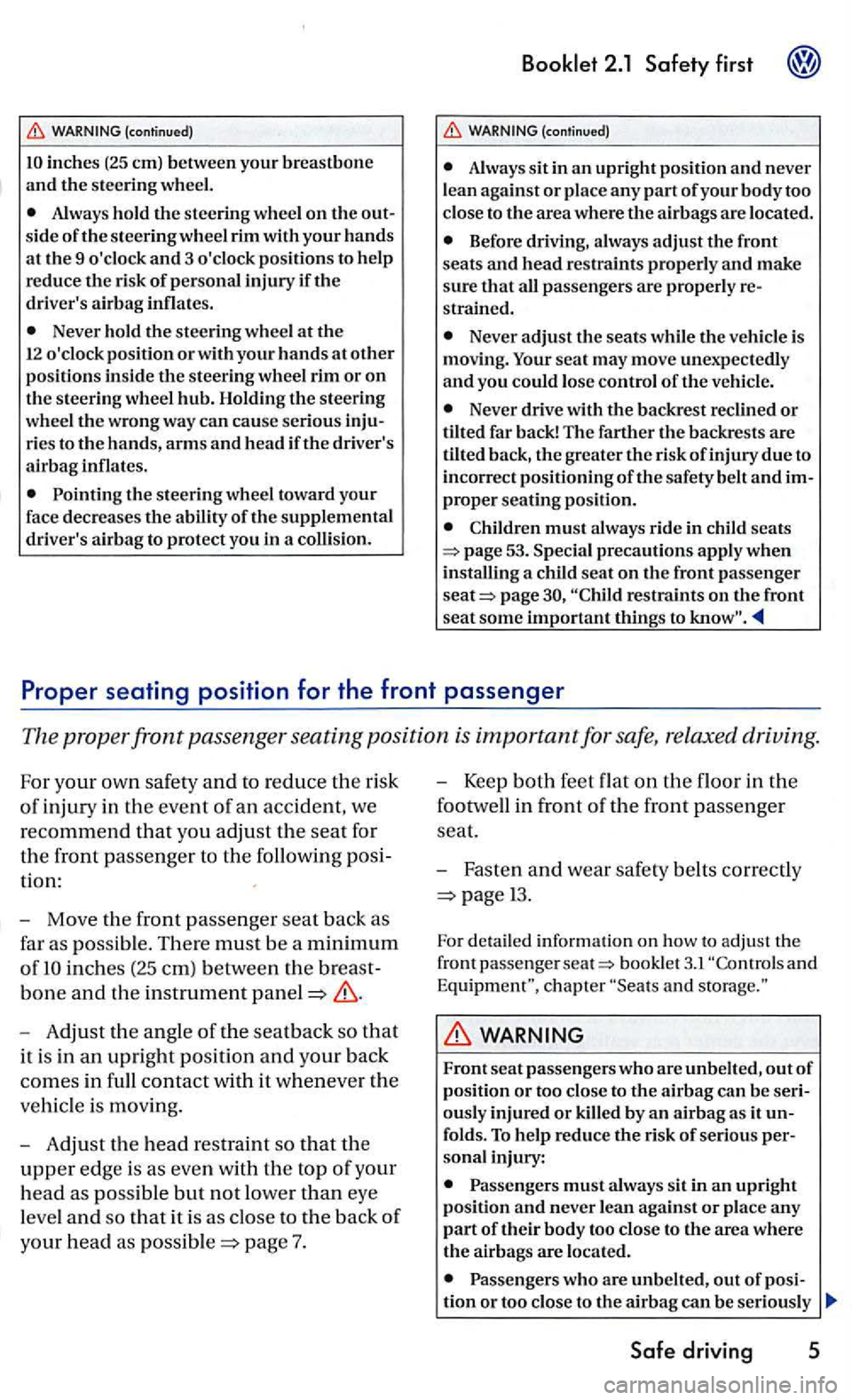
inches (25 em) between your breastbone and the steering wheel.
Always hold the s teering wheel on the
Never hold the steering wheel at the 12 o'clock position or with your hands at other positions inside the steering wheel rim or on the steering wheel hub. Holding the steering
wheel the wrong way can cause serious
2.1 Safety first
(continued)
Always sit in an upright posit i on and never lean against or place any part of your body too
close to the area where the airbags are located.
strained.
Never adjust the seats the vehicl e is mov ing. Your seat may move unexpecte dly and yo u could lose control of the vehicle.
Never drive wit11 the backrest reclined or tilted far back! The fart her t11e backrests are tilted back, the greater the risk of injury due to
incorrect positionin g ofthe safety belt and
Children must always ride in child seats
page restraints on t11e front seat some important things to
Move the front passenger seat back as
far as possible. There must be a minimum
of
Adjust th e angle of the seat back so that
it is in an upright position and your back
comes in full contact with it whenever the
veh icle is moving.
Adjust the head restra int so that the
upper edge is as eve n with the top of your
h
ead as poss ible but not lower than eye
leve l
and so that it is as close to the back of
your head as
Keep both feet flat on the floor in the
footwell in fron t
of the front passenger
seat.
Fasten and wea r safety belt s co rrectly
13.
For detail ed inform ation on how to adju st the
front passenger bookl et 3.1 and s torage.""
WARNING
Front seat passengers who are unbelted, out of posit ion or too close to the airbag can be
risk of serious
Passengers must always sit in an upright position and nev er lean against or place any part of their body too clos e to the area where the airbags are located.
Passengers who are u nbelted, out
Safe driving 5
Page 94 of 444
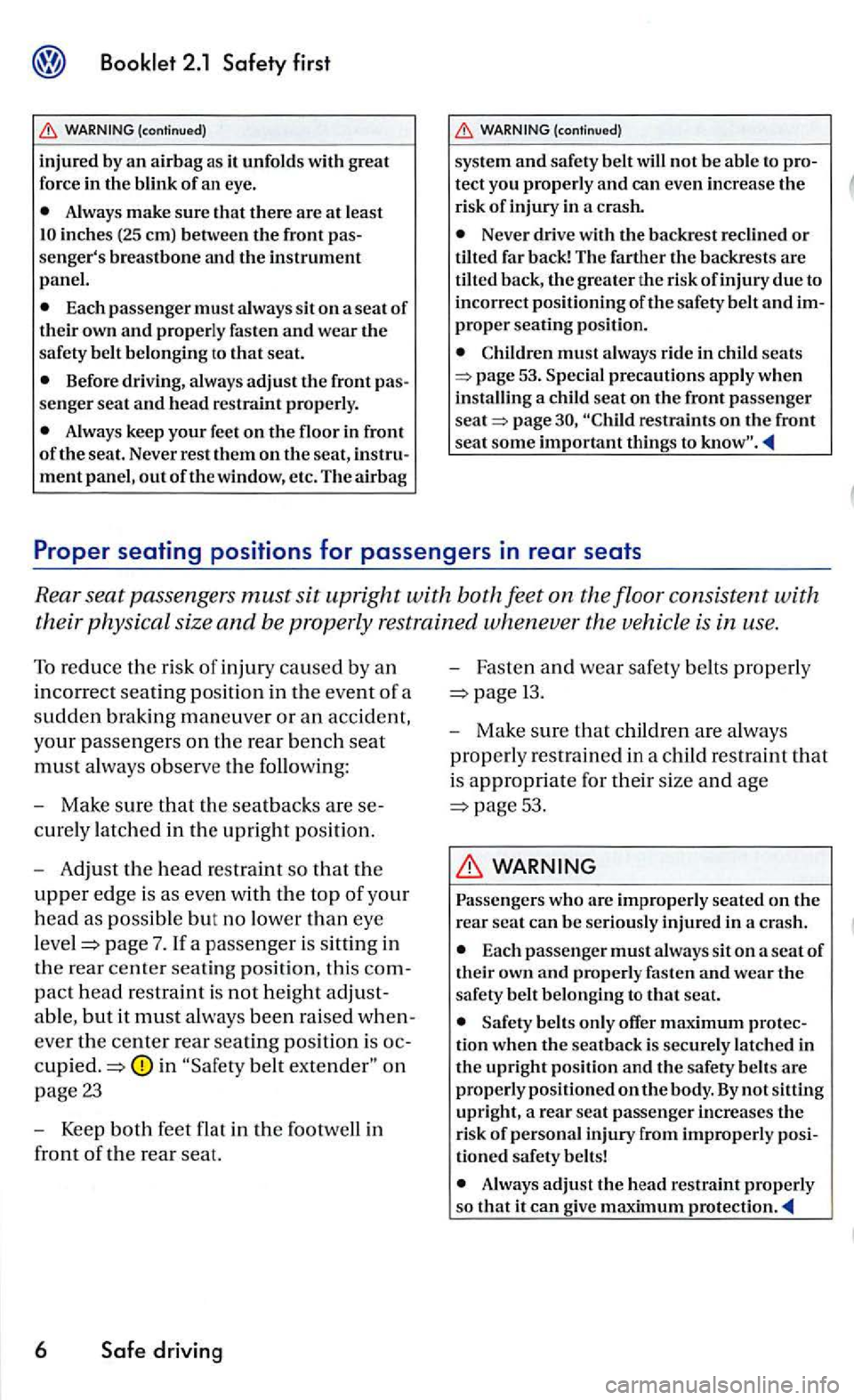
Always make sure that there are at least
Each passenger must always sit on a seat of their own and properly fasten and wear the safety belt be longing to that seat.
Before driving , always adjust the front senger seat and head re straint properly.
Alway s keep your feet on the floor in front of the seat. Never rest them on the seat, ment panel, out of the window, etc. The airbag
tect you properly and can even increa se th e
risk of injury in a crash.
Neve r drive with the backre st recl ined or tilted far back! The farth er the b ackrests are
tilted back, the greater the risk ofinjury due to
in correct positioning of the safety belt and
must always ride in seats 53. a child seat on the front passenger page
Mak e sure that the seatback s are
curel y lat ch ed in the upright position.
A djust th e head restraint so that the
upper edge is as even with the top of your
head as possible but no lower than eye
pag e 7. If a passe nger is s ittin g in
the rear center seating pos ition, this
pac t h ead restra int is not h eight
a ble , but it must always bee n rais ed
eve r the center rear seating posit ion is
belt on
page 23
Keep both feet flat in the footwell in
front
of the rear seat.
6 Safe driving
Fasten and wear safe ty belt s properly
13.
Make sure that children are always
prop e
rly restra in ed in a child re str aint that
is appropriate for thei r size and age
5 3 .
WARNING
Pas sengers who are improperly seated on the rear seat can be se riou sly injure d in a crash.
Each passen ge r must always sit on a seat of th eir own and properly fasten and wear the safety belt belonging to that seat.
belt s only offer maximum tion when the seat back is securely latched in
th e upright po siti on and the safety belts are
properly positioned on the body. By not sitting
upright , a re ar seat pass enger increases the risk of personal injury from improperl y
Always adjust the head restraint properly so that it can give maximum
Page 105 of 444
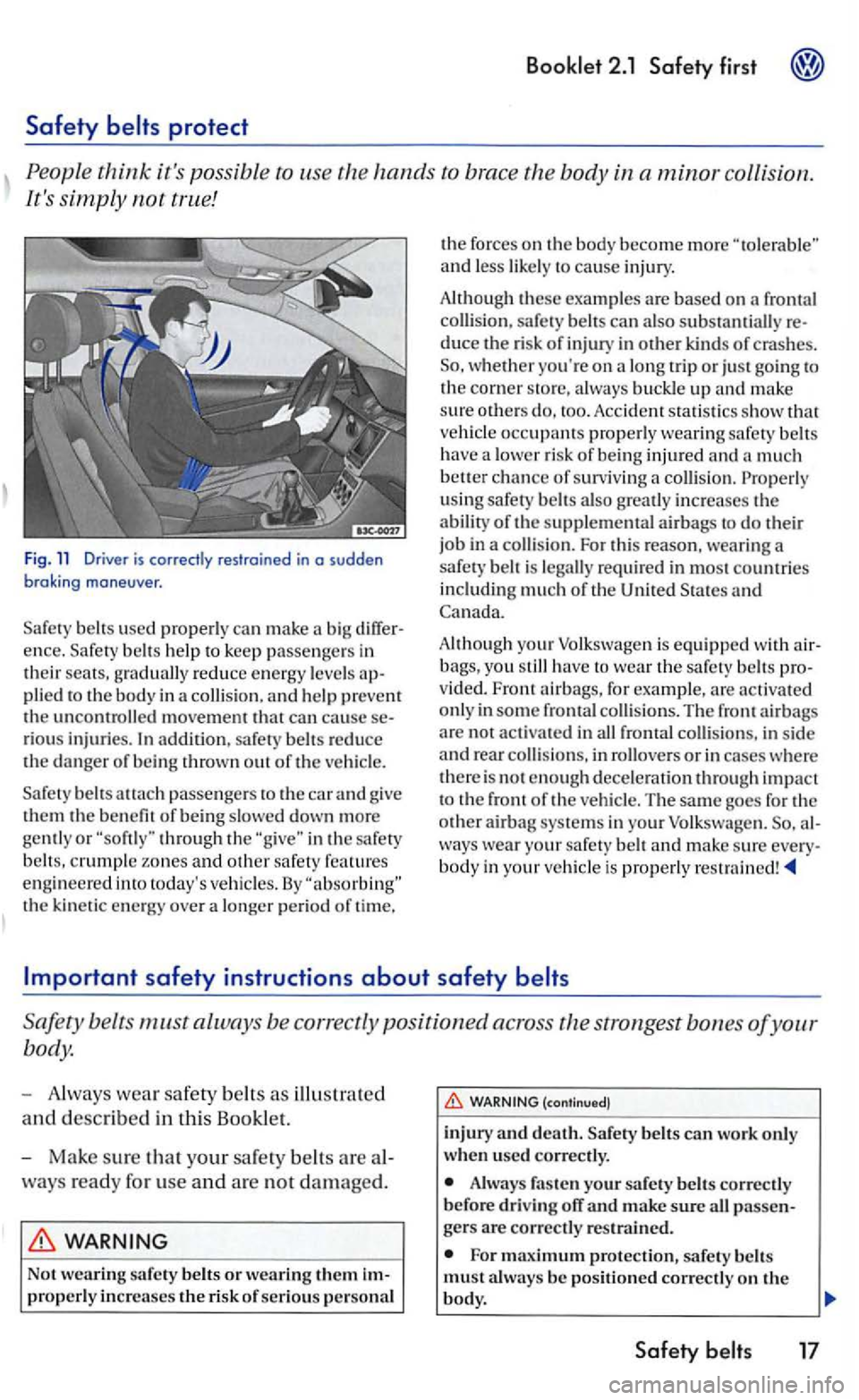
Booklet 2.1 Safety first
Safety
Fig . 11 Driver is correctly restrained in a sudden braking maneu ve r.
used properly can make a big differ
e n ce . help to kee p passenge rs in
t h ei r gradually red uce energy levels applied to the body in a collisio n. an d h elp prevent
t h e uncontrolled movement that can cause se
r ious injuries. additio n, safety reduce the danger of being throw n out of the vehicle.
passengers to the car and give them the benefi t o f being slowed down more ge ntly or t hroug h the c rumple zones and oth er sa fety features engineered today's vehicles. By
hough these examples are based on
Acci dent statist ics show that
veh icle occupants prop erly wearing safety have a lowe r risk of being i n ju red and
pro
v id ed . Fron t airbags, for example, are activated
only in some frontal collisions. The front airbags
are not activated in all frontal collision s, in side and rea r collisions, in rollovers or in cases where
there is not e n ough deceleration through impact
to the front of the ve hicle. The sa me goes for the
o ther airbag systems in your Volk sw age n. al
ways wear your saf ety
safety instructions about safety
Safety belts must always be correctly positioned across
Always wear safety belts as illu strate d
a
nd d esc ribed in thi s Book let.
WARNING
Not wearing safety belt s or w earin g them im
p ro perl y in cre ases the ri sk of serio us pe rso nal
Always fas te n your safety belt s correc tly
before driv ing off and make su re all passen gers are corr ec tly res traine d.
For m aximum protectio n, safe ty belts must a lways be pos itioned correctly on the
Safety belts 17
Page 111 of 444
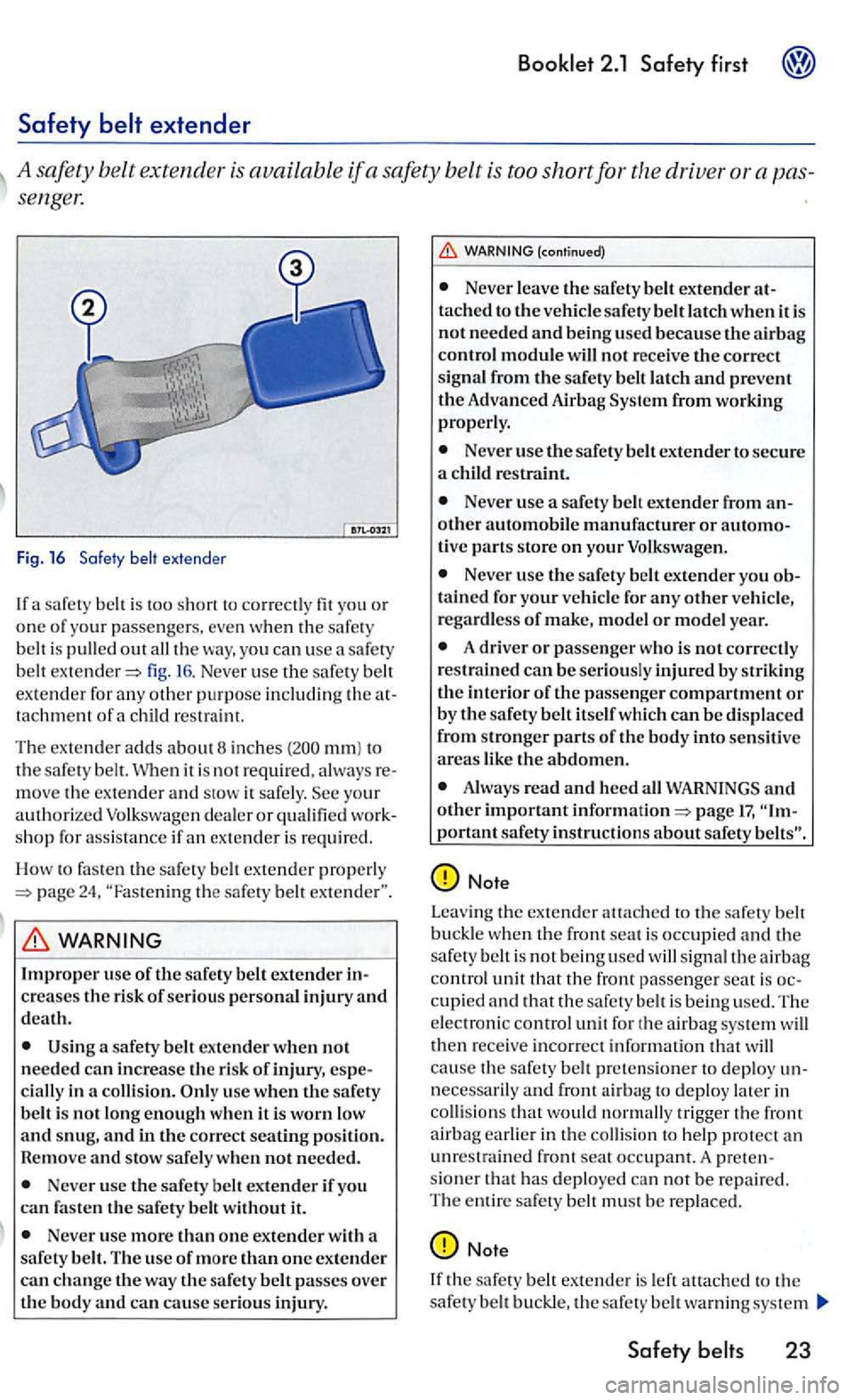
Safety
sengel:
Fig. 16 Safe ty
out fig . 16 . Never use th e safe ty belt
ex tende r for any oth er purpo se includin g th e tachment of a c hild restraint.
Th e
exte nder adds a boutB inches mm) to
the safery belt. Whe n it is not require d , always
s hop for a ss is tan ce if an extende r is requ ired .
H ow to fas te n the s
afety belt extender properly 24, th e sa fe ty belt
crea ses the risk of seriou s personal injury and death.
a safery belt exten de r w hen not needed can increase the risk of injury , cially in a collision. it is worn low
and snug, and in the cor rec t seating position.
R emove and sto w safe ly when not needed.
Never use the safet y belt extender if yo u
ca n fasten the sa fety belt without it.
Never use more than one extender with a
safery be lt. The use of m ore than one extender c a n ch ang e the way the sa fe ty belt passes over
the body and can cause se rious injury .
Never leave the saferybelt extender ta ched to the veh icle safe ty belt latch when it is not needed and being used because th e airbag control module will not re ceive the correc t
s ign al from the safety b elt la tc h and prevent the Advanc ed Airbag from working properly .
Never use the safe ty belt extender to secure
a child restraint.
Never use a safery belt ex tender from
Nev er u se the safery belt extend er yo u tained for your vehicle for any other vehicle,
regardless of make, model or model year.
A driver or pass enger w ho is not correct ly
re strained can be seriously injured b y striki ng the interior of the passe ng er compartment or by the safery b elt its elf whi ch can b e di spla ced
from stronger parts of the body into se nsiti ve areas lik e th e abdomen.
Always read and heed all WARNINGS and other important pa ge
signal th e airbag
co ntrol unit that the front passenge r seat is
ca use the s afery belt prete nsio n er to deploy necessarily and fron t to deplo y la ter in
collision s th at would trigge r the front
a irb ag earlie r in th e to help pro tect an unrestrain ed front seat occ upant. A sioner that has dep loyed can not b e repair ed.
T he entire sa fety belt mu st b e rep laced.
Safety
Page 114 of 444
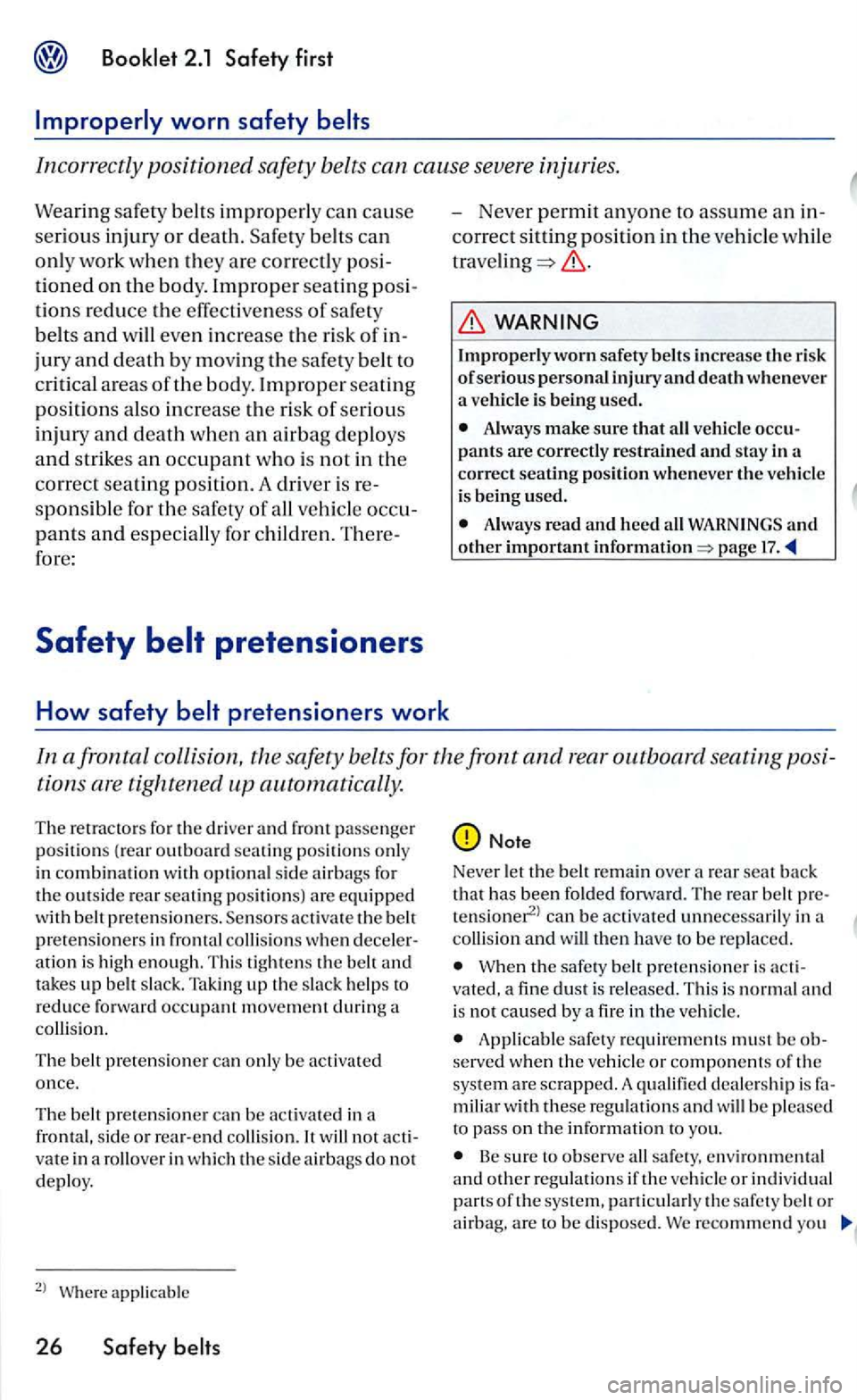
Incorrectly positioned safety belts can cause severe injuries .
Wearing safe ty belts improperly ca n cause
seriou s inju ry or death. belts can
only work when they are correctly
tioned on the body.
tions reduce the eff ective ness of safety
belt s
and even increase the ris k of
jury and death by moving the safe ty belt to
c riti
cal a reas of th e body. Improper seatin g
position s also increase the risk of serious
inju ry and death when an airbag deploys
and strike s an occupant who is not in the
correct
seating pos ition. A driver is
sponsible for the safety of
pants and especially fo r chi ldren.
for e:
Safety
correct si ttin g posi tion in the vehicle whil e
Improperly worn safety belts increas e th e risk of serious personal injury and death w he neve r
a ve hicl e is being used.
make sure that all vehicle pants are correctly restrained and stay in a correct seating position whenever the ve hicle
i s being used.
page
In a frontal collision, the safety belts for the front and rear outboard seating
ation is high enough . Thi s tighten s th e belt and takes up belt slack. Taking up the slack help s to reduce forward occupant m ove ment during a
collision.
Th e
belt pretensioner can only be act iva ted once.
The belt pre te nsio ner can be activated in a
frontal , side or r ea r-end collision . will no t vate in a rollover in wh ic h the sid e airbag s do not
depl oy.
2l Where applicabl e
26 Safety
can be activa te d unnecess arily in a and will then have to be replac ed .
W he n the safe ty belt pretensioner is
Applicable safety requirements must be se rve d whe n the vehicle or components of the
syste m are scrap ped . A qualified dealers hip is miliar with these re gulation s a nd be pleased to pass on the information to you .
Be sure to observe safe ty, environmenta l and other reg ulat ions if th e ve hicl e or indiv idual
part s oft he system, parti cularl y the safe ty belt or airbag, are to be di sposed. We recommend you
Page 116 of 444
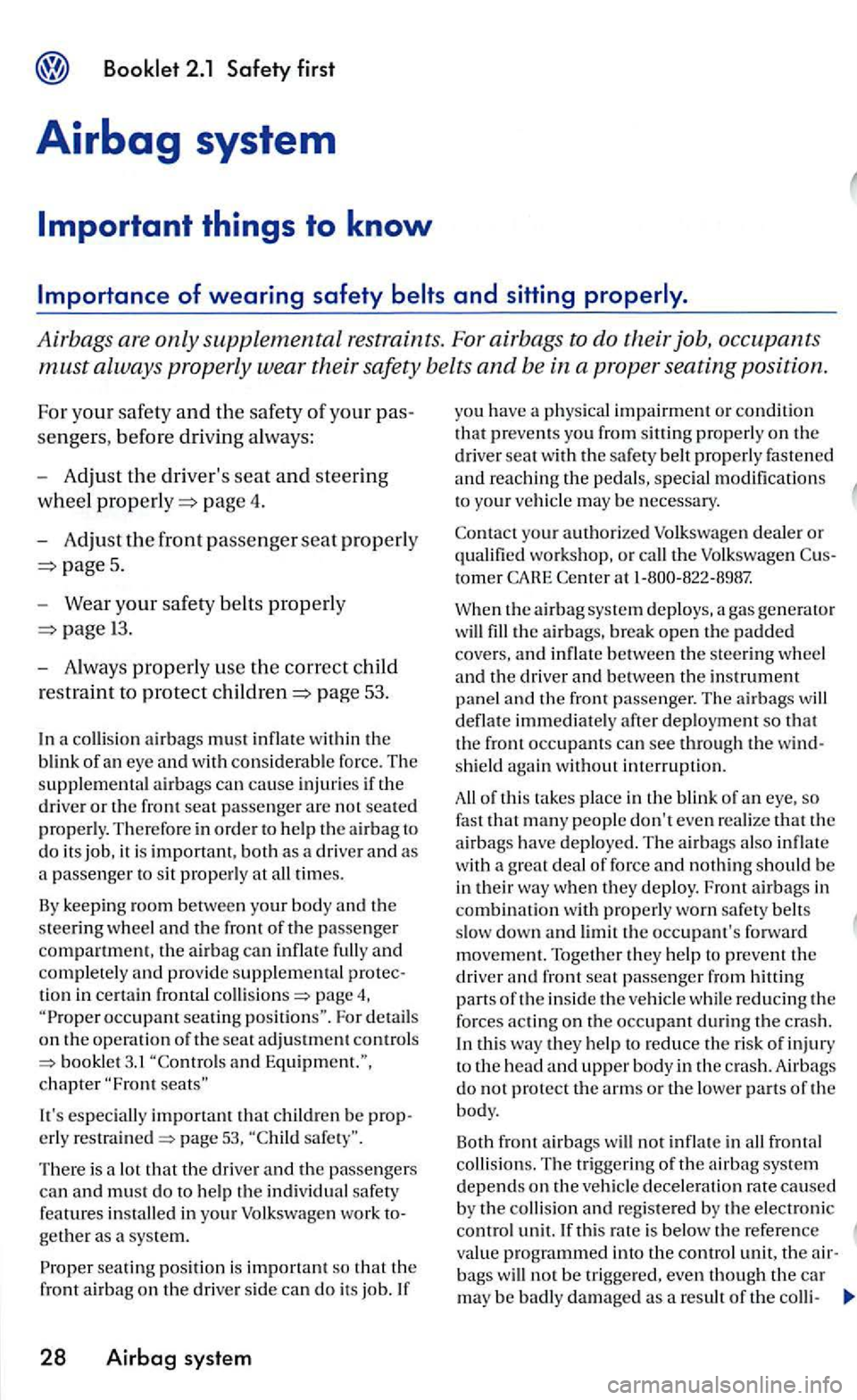
2.1 Safety first
Airbag system
Important things to know
Airbags are only supplemental re straint s. For airbags to do their job,
sen gers, befor e dri vin g a lw ay s:
- Adju st th e driver' s
seat and steering
w heel
5.
- Wear y
our safety be lt s properly
13.
- Always properly use the correct child
re straint
to protect page 53.
a co llisio n airbags mu st
times.
keep in g roo m be tween your bo d y and the
s teerin g w heel and the front of the passe nge r the ai rb ag can and completely and pro vid e supplemental page 4, occupant seatin g For details on th e o perati on of the seat adju stment control s and
important th at page 53,
There is a tha t the dri ver and th e passengers can and must d o t o h elp the individual safe ty feature s work
seating position is important so that the fron t airb ag on the drive r sid e c an do its job.
28 Airbag system
you h ave a physical impairment o r condition that prevents you from sitti ng properly on the
driver seat w ith the safe ty
may be necessary .
your au th o rize d dealer or qualified workshop, or the to mer
When the ai rbag syste m deploys, a gas generato r the ai rbags. brea k ope n the padded cove rs, and
shie ld again without interruptio n.
o f thi s tak es place in the of a n eye, so fast th at many people don 'teven realize that the airbags ha ve deplo yed. The airb ags also
reducing th e forces actin g o n the occupant d ur in g t he crash . th is way th ey help to re duce the ris k of in ju ry
t o the head and uppe r bo dy in t he cra s h. Airbags
d o not protect the arms or the lowe r parts of th e
body.
Both f ront a irb ags no t fro nta l
collisio ns. The tr igger ing o f the airbag sys te m
d epend s o n the an d re gis te re d by the electronic
contro l unit.
b ags
Page 117 of 444
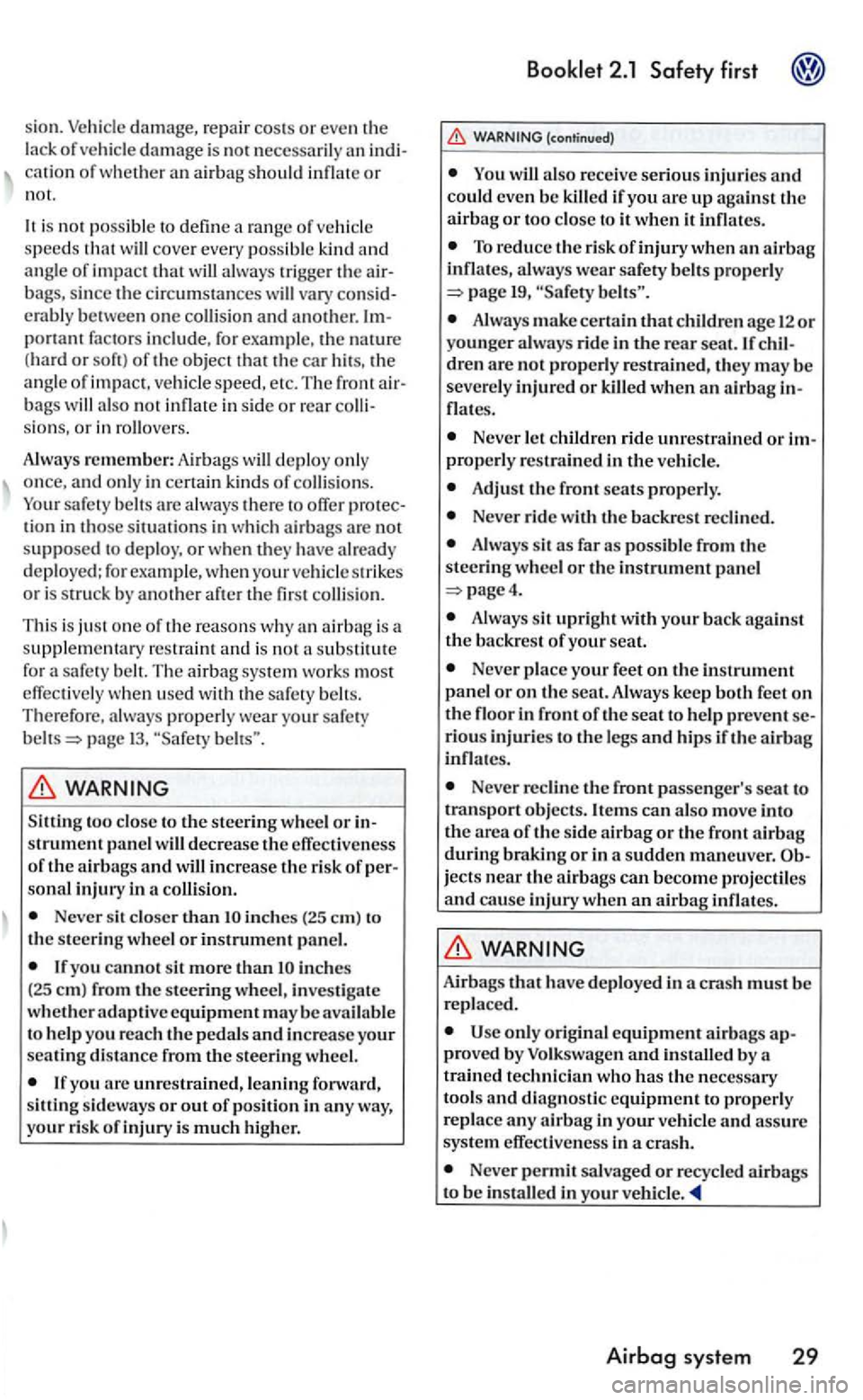
sion. d am age, repair co sts or eve n the
l ack of damage is no t an of w het her an airb ag s ho uld o r
not.
i s no t po ssible to define cove r every poss ibl e kind and an g le of impact that alway s tri gge r th e bags , s ince th e c ircumstan ces vary era b ly be tw ee n one po rt ant factors include , for examp le, the natur e
( hard or so ft) of th e objec t that the ca r hi ts, th e
angle of imp act, vehicle speed, etc. The front bag s als o no t in side or rear sio ns, orin rollove rs .
Always re m em ber: Airb ags
depl oy only
once, and only in certain kinds of collisions. safety b elts are always th ere to tion in th o se situ ations in w hi ch airb ags are not supposed t o dep loy . o r when they have already
d eployed; for exa mpl e, wh en yo ur
sub stitut e for safe ty bel t. The airba g syste m wor ks mo st
effectivel y w he n u sed with the sa fety belts. Therefore , always properly wear your sa fety
WARNING
S itting too clo se to the stee rin g wheel or strument pa n el will decrease the effec tiv en ess of the airbags and will increase the risk of sonal injury in a co llision.
Ne ver sit clo se r than in ch es (25 em ) to th e steering wheel or instrument panel.
If you cannot sit more than
first
(continued)
to it when it
To redu ce the risk of injury when an airbag inflates, always wear safety belts properly 19,
Always make certain that children age 12 or younge r always rid e in the rear seat. If dren are not properly restrained, they may be sever ely injured or killed when an airb ag flat es.
Never le t childr en ride unrestrained or
Adju st the front seats properly.
Never rid e w ith the backr est
Always sit as far as poss ible from the steerin g whee l or the instrument panel
Alway s sit upright with your back against the backrest of your seat.
Neve r place your feet on the in strument panel or on th e seat . Always keep both feet on the in front of the seat to help preven t rio us in juri es to the legs and hip s if the a irbag
infl ates.
Never reclin e the front passenger 's seat to transport objects. Item s can also move into the area of th e s ide alrbag or the front airbag during braking or in a sudden maneuver. jects b eco me projectiles and caus e injury when an airbag infl ates.
WARNING
Airbags that have deplo yed in a cra sh mus t b e replaced .
onl y o riginal equipment airbags proved by Volkswagen and Installed by a
trained technician who has th e necessary tool s and diagnostic equipment to properly replace any airbag in your
Never permit salvage d or recycled airba gs
to be installed in your vehic le.
Airbag system 29
Page 118 of 444
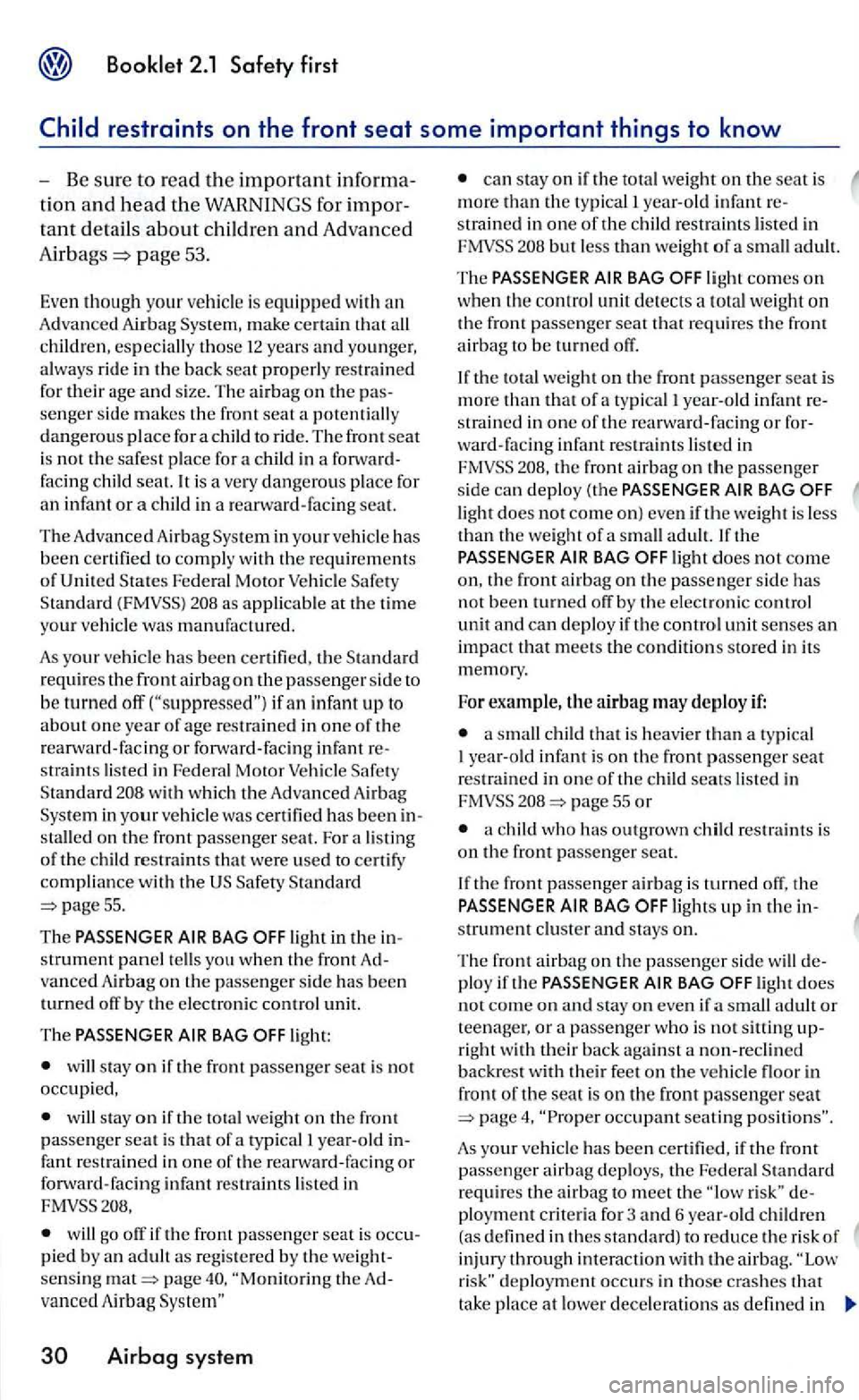
page 53.
Eve n though your vehicl e is equipped wit h an Advanced Airbag System, make certain that all childre n , especially those 12 years and younger, a lways ride in the back seat properly restrained for their
if an infant up to about one year of age restrained in on e of the rearward-fac ing or forward-facing infant re
straints lis ted in Federal Mo tor Standard 208 with which the Advanced Airbag Sys te m in your was certified has been installed on the front passenger seat. For a listing of the child restraints that were used certify compli ance with the
55.
The PASSENGER
will stay on if the front passenger seat is not occupied,
will stay o n if the tot al weight o n the front passenger seat is that of a typical year-o ld infant restrain ed in one of th e rearward-facing or forward-fa cing infant restraints listed in
w ill go off if the front passenger seat is occupied by a n adult as re gis te red by the weightsen sin g page 40,
can stay on if the weight on the seat is more than th e typical! year-o ld infant re-
strained i n one of the child restraints li sted in 208 but less than weigh t of a small
the total weigh t on the front passenger seat is more tha n that of a typica l
208, the front airbag on the passenger side can deploy (the PASSENGER
light does not come on) even if the weight is less than the weight of a small adult. I f the PASSENGER light does not come o n, th e front airbag o n the passenger side has not been turned off by th e e lectronic control unit and can deploy if the control unit senses an impact that meets the conditions stored in its
memory.
For example, the airbag may deploy if:
a small chil d that is heavie r than a typical year-old infant is on the front passenger seat restrained in one of the c hild seats liste d in 20 8 page 55 or
a child who has outgrown child restraints is on the front passenger seat.
If the front passenger airbag is turned off, the PASSENGER and sta ys on.
The front airbag on the passenger sid e w ill deplo y if the PASSENGER BAG lig ht does not come on and sta y on even if a small or teenager, or passenger who is not sitting up
right w ith their back against a non-recl in ed bac kre st with th eir feet on the in
front of the seat i s on the
deployment occurs in those crashes that ta ke place at lowe r decelera ti o ns as defined in